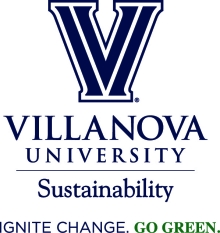LEED Certified Buildings
Leadership in Energy and Environmental Design (LEED) is a rating system for buildings to rank their comprehensive use of sustainable design techniques. Developed by the US Green Building Council (USGBC) in a transparent, consensus-based process, LEED is the leading rating system for green buildings, required by many local municipalities, as well as the US General Services Administration (GSA) for all new construction and major renovation of Federally-owned buildings. LEED projects earn points in nine basic categories for green buildings: Integrative Process, Location and transportation, Sustainable Sites, Water Efficiency, Energy & Atmosphere, Materials & Resources, Indoor Environmental Quality, Innovation, and Regional Priority. Villanova has eight LEED certified buildings on campus: the Law School, Driscoll Hall, Fedigan Hall, Sheehan Hall, Sullivan Hall, the Andrew J. Talley Athletic Center, Austin Hall, and the Commons.
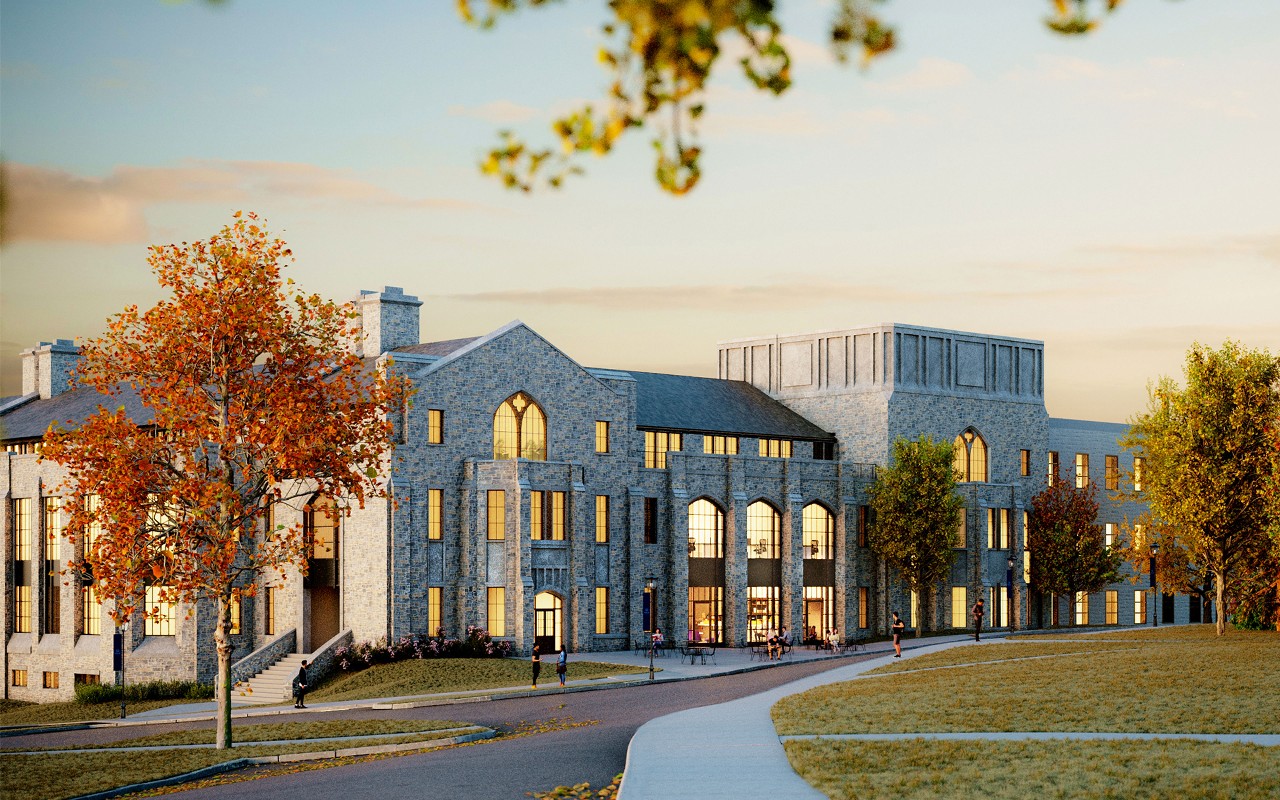
Drosdick Hall
Drosdick Hall is an expansion of the previously named CEER building to consolidate the program requirements for the College of Engineering and Energy Research. It is a key element of the University’s Master Plan to provide additional space and infrastructure to the College of Engineering. With an aesthetically impressive and highly functional building, the expansion is designed and built to facilitate the College of Engineering’s innovative educational paradigms that emphasize hands-on, experiential and collaborative learning.
The project was awarded a LEED Silver certification under v4 of the LEED New Construction rating system. The project took sustainable design cues from existing certified buildings on campus, while also incorporating principles from other sustainable design certifications.
Great care was taken in designing and building Drosdick hall to sustainable standards, guided by the LEED rating system. Read the case study for more information.
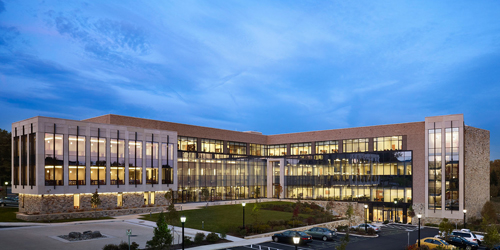
Law School
The Law School, completed in 2009, is a LEED Gold building that features a number of sustainable design features including thoughtful building orientation, high efficiency window selection, a white roof, and strategic room layout that resulted in a 23% reduction in energy usage. The building utilizes 41% less water though the use of water efficient fixtures, such as dual flush toilets and motion sensitive faucets. In addition, only native plants were used for the building’s landscaping. All rain that falls on the building is collected on site through the stormwater wetlands, which provides our students with a great source for experimentation and data collection. 95% of all construction waste generated for this building was recycled! Sustainable materials were also used including products with recycled content, regionally sourced materials, and FSC certified wood. When commuting to the school, occupants have a number of options enhanced by the design of the building, including bicycle racks, electric vehicle charging stations, and easy access to public transportation through the SEPTA regional rail line. Once in the building, occupants have a clean and welcoming learning environment enhanced with the use of low VOC paints, access to daylight, lightly colored walls to reflect light, and superior air filtration. After 6 months of occupancy, a comfort survey was distributed and the results came back above average in their positivity towards the building. Use this link for the complete LEED scorecard.
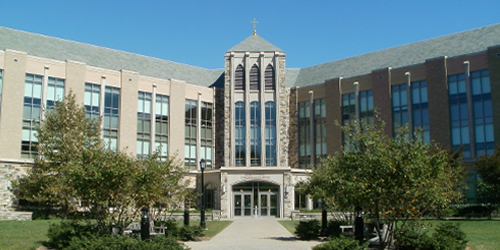
Driscoll Hall
Driscoll Hall; the home for the Villanova's College of Nursing, was finished in 2008, receiving a LEED Gold certification. The building was designed to efficiently use all resources, including energy, water, building materials, and more. Driscoll uses 22% less energy and 37% less water. 86% of the waste generated during construction was recycled. The building materials used were also sustainable, with 22% of materials made using recycled content, 14% regional content, and 74% of the wood sourced from FSC certified suppliers. The building's white roof top and surrounding hardscape shaded by trees reduce the building’s heat island. The main entrance has a small green roof, which helps to reduce rain runoff. Additional stormwater runoff is collected in an underground detention facility and slowly released into the ground to replenish the aquifer. Bike racks and showers are available to building occupants and visitors. Once inside the building, low VOC paints and carpets provides a clean environment to work and learn in. For the complete LEED scorcard, use this link.
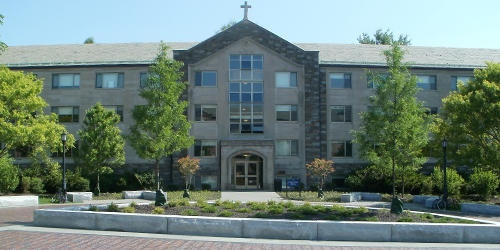
Sheehan and Sullivan Halls
In 2011, Sheehan and Sullivan Halls were renovated under the LEED Commercial Interiors standard, each receiving a LEED Silver rating in 2013. The buildings’ redesign included the replacement of water fixtures with dual flush toilets, low flow shower heads, and motion sensitive water faucets, resulting in 25% less potable water use. In an effort to reduce energy usage, the buildings’ lighting power density were lowered by more than 50% by replacing older, less efficient lighting with newer, more efficient technology. Throughout the renovation, 92% of the waste was diverted from the landfill to be recycled. Much of the new building materials were made out of recycled and/or regionally harvested and manufactured material. Building occupants enjoy a cleaner indoor air with the use of low VOC paint. Additionally, over three quarters of the dormitories has access to daylight, lessening occupants’ needs for artificial lighting. For each buildings complete LEED scorecard use the following links: Sheehan and Sullivan.
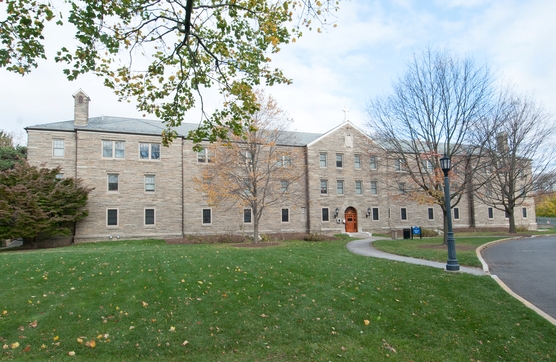
Fedigan Hall
In 2013 Fedegan Hall, nicknamed the “Green Dorm”, achieved LEED Gold certification under Commercial Interiors. The dorm has a number of new sustainable features that help the building live up to its name including a geothermal system, the only building on campus to have this system. Geothermal energy utilizes the semi-constant temperature of the earth’s crust to heat and cool a building. Rain gardens span the entire east side of the building, collecting rain runoff from the building. Additionally, rain barrels are located behind the building to capture any excess water runoff. That water is used to irrigate the surrounding vegetation. Bike racks are located near the entrance of the building for safe and easy storage. Water fixtures inside of the building were replaced with more efficient fittings, including dual flush toilets and low flow showerheads. Energy efficiency was increased by reducing the lighting power density by 55% and using only Energy Star Certified appliances. Occupants enjoy easy access to daylight and views throughout the building, resulting in a reduced need for artificial lighting. For the complete LEED scorcard, use this link.
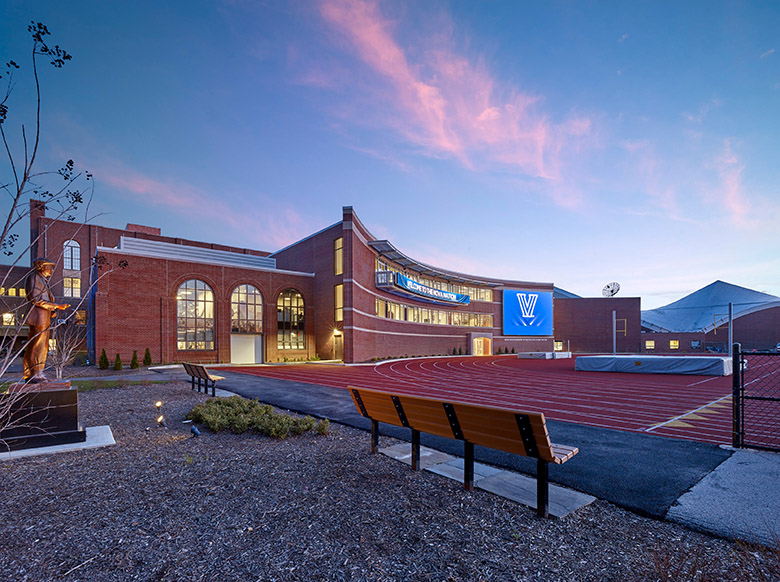
Photo Credit: Don Pearse Photographers, Inc.
Andrew J. Talley Athletic Center
The Andrew J. Talley Athletic Center was completed in 2016 and was awarded LEED Silver certification. The Talley Center is attached to the Jake Nevin Field House, and is designed to reduce energy and water usage 20% and 30%, respectively. The building process incorporated recycled construction materials in an effort to meet university sustainability goals. The center is home to the sports medicine program, the Howie Long Training Center, academic support center, equipment room, meeting rooms, offices, and a new locker room for the football team. For the complete LEED scorecard, use this link.
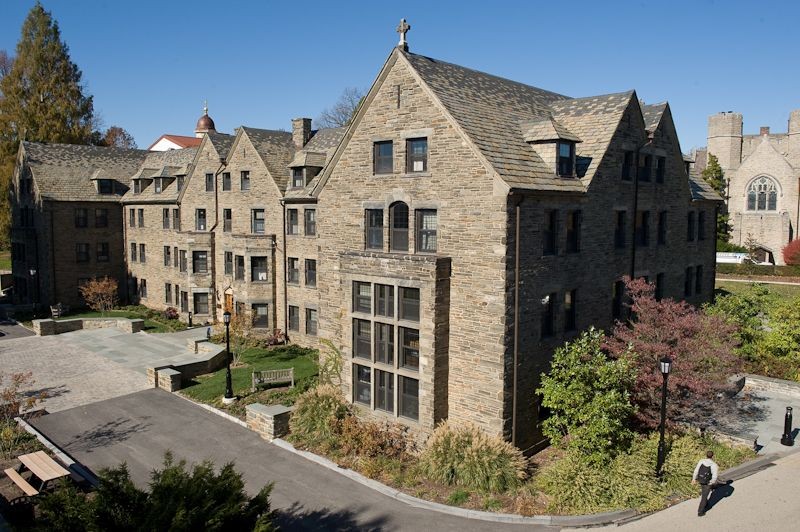
Austin Hall
In 2018, renovations to Austin Hall were completed, and the building was certified LEED silver. New construction incorporated recycled materials which made up 17.5% of the total building material. Additionally, 79% of the construction waste was diverted from landfills, through recycling or reuse. The redesign of the building focused on increased resource efficiency for both energy and water. Upgrades included low flow water fixtures, which led to a 40% reduction in potable water use, and new, more efficient lighting equipped with occupancy sensors. Lighting controls were installed in all shared, multi-occupant spaces. These changes to the lighting system reduced the lighting demanded power in the building by 43%. Use this link for the complete LEED scorecard.
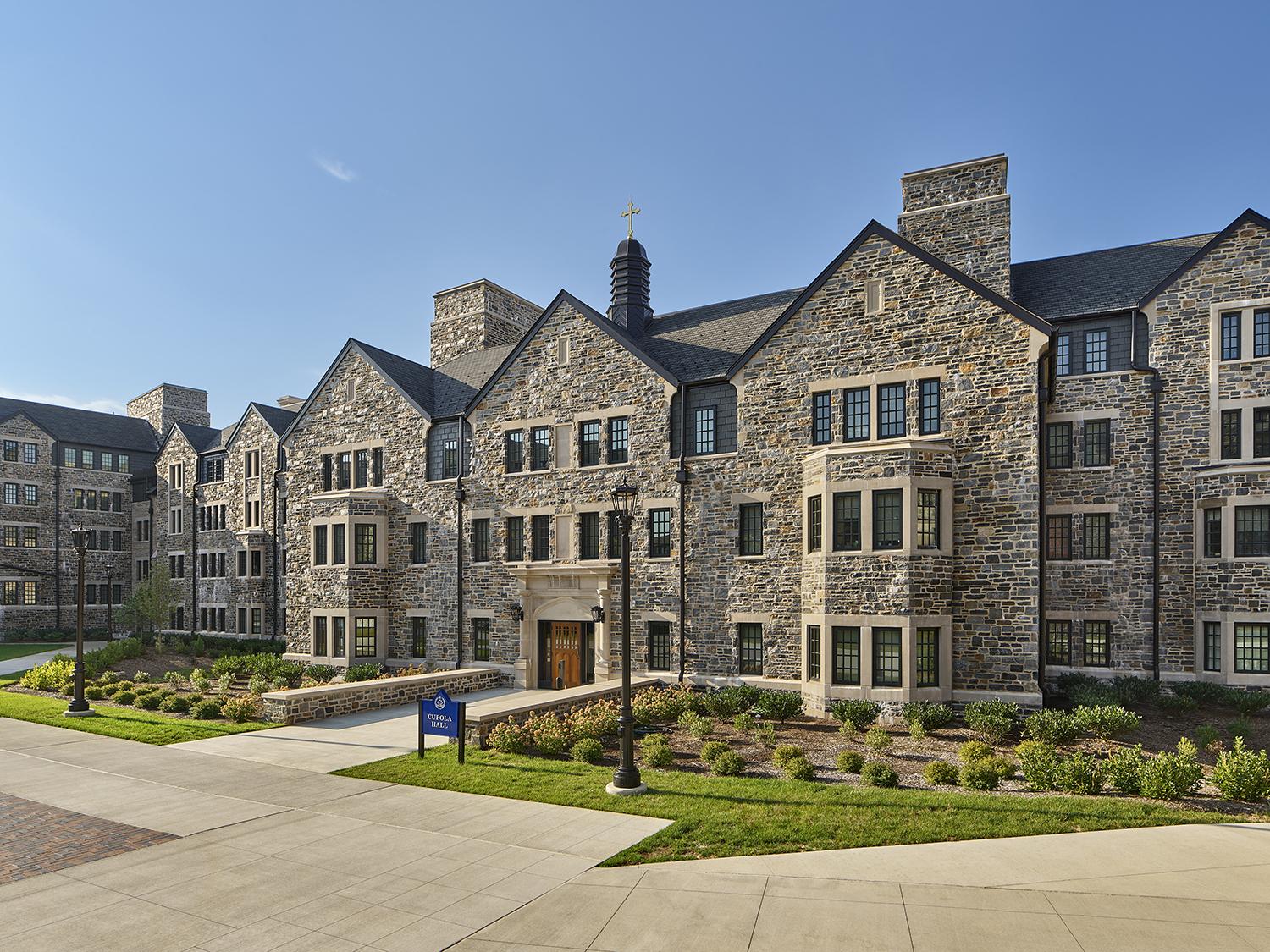
The Commons
Villanova’s newest Living and Learning Community, the Commons, was certified LEED silver in May 2020. The Commons, which contains six residence halls, capable of housing 1,135 students, is powered by 100% renewable electricity. It also is designed with increased energy efficiency in mind, resulting in an anticipated 17% cost savings. Some of the elements that contribute to such efficiency include vacancy sensors for the lighting, and occupancy sensors for heating and cooling. During the construction of this community, 87% of waste from the site was recycled or reused, rather than going to the landfill. The surrounding environment includes bioswales to filter surface water runoff, and underground cisterns collecting stormwater from the roofs, which is then reused in the cooling of the buildings. An estimated 400,000 gallons of water can be saved by the sustainable design of the Commons. Use this link for the complete LEED scorecard.
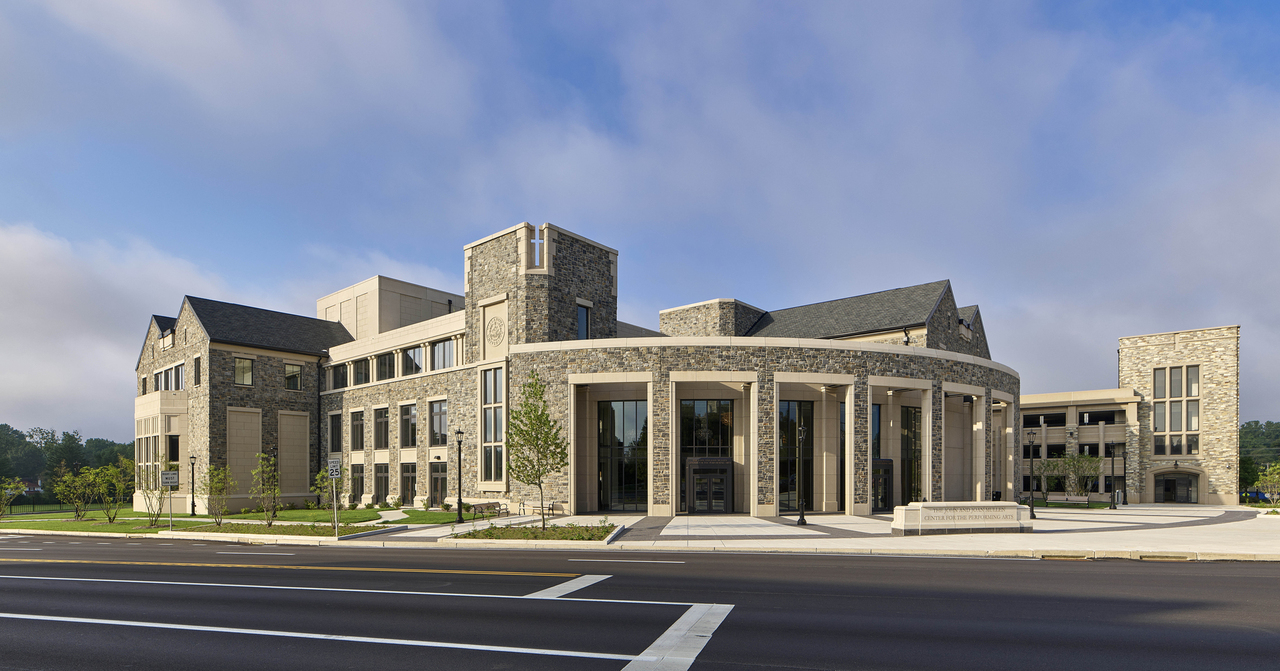
Mullen Center
Villanova's new Performing Arts Center was certified LEED silver in Spetmber of 2021. The approximately 85,000 square foot Mullen Center features three state-of-the-art performance spaces, as well as studios and classrooms to support education and innovation. 100% of the expected electricity used in the Performing Arts hall will be offset by hydro power purchased from the Holtwood, PA facility. Villanova also partnered with Revolution Recovery while constructing this building to divert over 75% of the project construction waste from landfills. In addition, the PAC utilizes a green roof to reduce the effect of heat islands, and to improve air quality through absorption of pollutants. For a complete list of sustainability features in the new Mullen Center, view this newsletter. To view the LEED scorecard, use this link.

